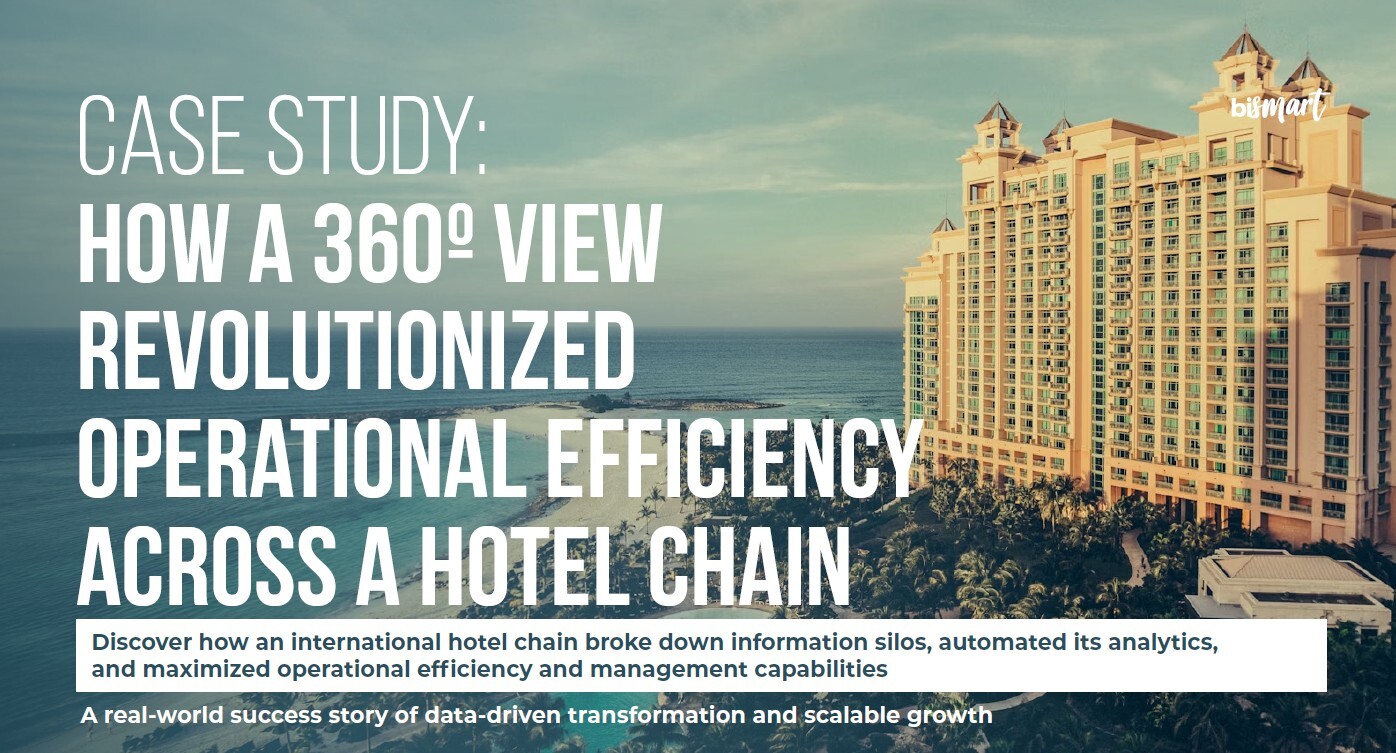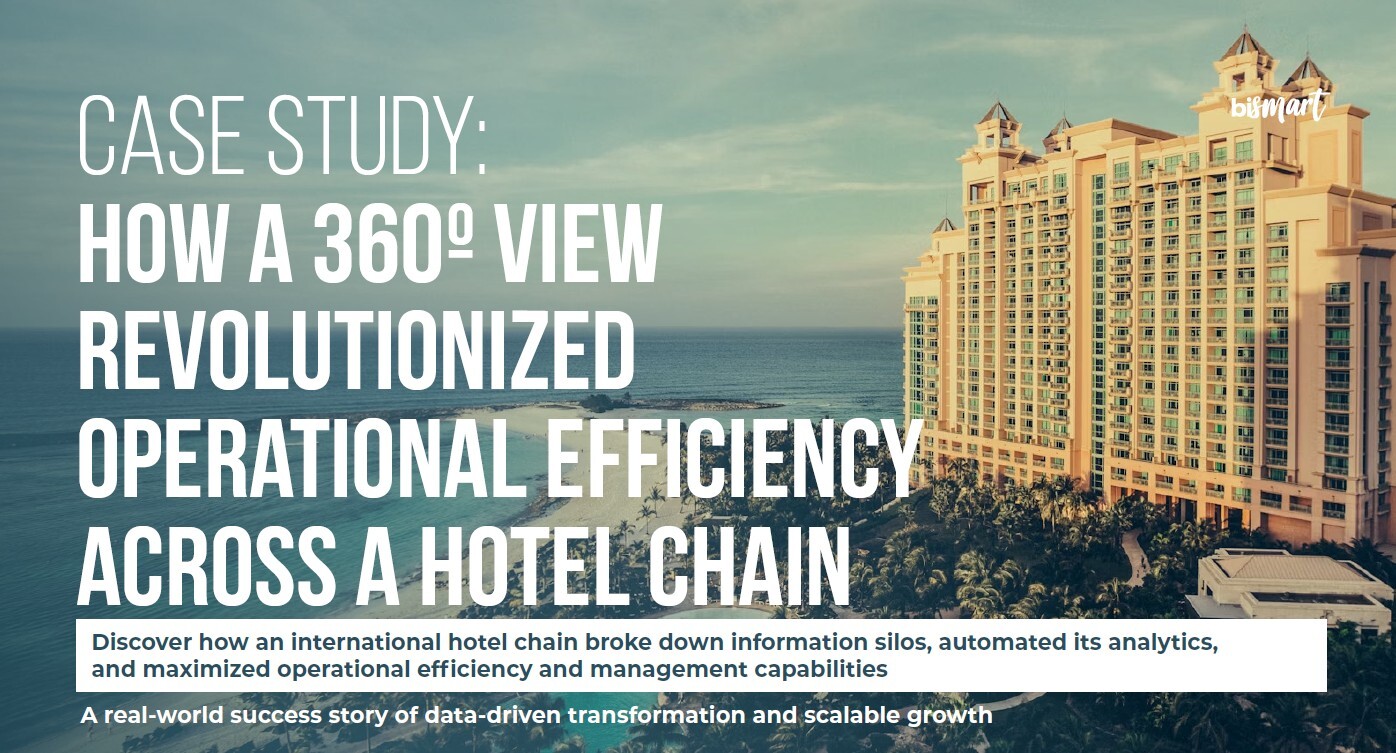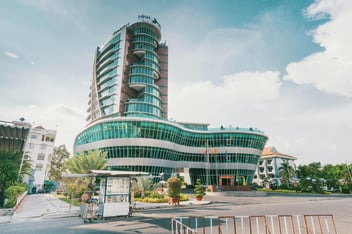Discover how an international hotel chain optimized its efficiency and achieved a 360º vision with advanced hotel management software. Case study.
In the hotel industry, the ability to manage and analyze data has become a decisive factor in optimizing operational efficiency and maintaining competitiveness. However, many hotel chains continue to work with fragmented information, distributed across systems and applications that do not communicate with each other.
Each department tends to use its own tools: a PMS for hotel reservations management, other software for the restaurant area, spreadsheets for finance, among others - which makes it difficult to have a global and consolidated vision of the hotel operation.
This isolated approach limits the ability of management teams to understand the operation as a whole, slows down decision making and complicates the identification of inefficiencies or areas for improvement.
In this scenario, the traditional PMS (Property Management System), although essential for daily operations -reservations, check-in and check-out, billing-, has structural limitations: it is not designed to offer a comprehensive strategic vision or to cross-reference data from different sources and functional areas.
For this reason, hotel chains that are committed to innovation are incorporating more advanced solutions: advanced analytics tools that centralize information, integrate data from all operational systems and offer a complete and up-to-date perspective of the business.
In this article we analyze the characteristics of this type of advanced hotel management softwareand its differences with respect to a traditional PMS.
We also explain a case study that illustrates the tangible benefits obtained by an international chain after adopting this approach. The chain was able to obtain a 360º vision of its hotel chain (multihotel) and transform its operational management.
What Is Advanced Hotel Management Software And How Does It Differ From a PMS?
Advanced hotel management software should not be confused with a conventional PMS. Although a PMS is also a hotel software, it is oriented to the daily operational management -reservations, check-in and billing-. Advanced software, on the other hand, offers a much broader strategic vision.
It is a comprehensive business intelligence and data analytics solution, essential for all hotel chains that currently need to consolidate large volumes of information, cross-reference data from multiple sources and obtain accurate indicators for decision-making with real impact.
Advanced hotel management software must provide a global and integrated vision of all the areas and properties of a hotel chain, unlike traditional PMSs that are limited to specific operations per hotel.
On the other hand, it must allow the integration of multiple data sources (PMS, CRM, POS, finance, online reputation, external data, etc.), consolidating them into a single model that eliminates manual processes.
Also, these software must have the ability to perform cross-analysis and strategic analysis, combining information from different areas to detect patterns.
Finally, some of these softwares for hotels incorporate predictive analytics. This is the case of Hotel Management Dashboards, a hotel management software that unifies all the key data of a hotel chain in a single analytical environment and incorporates a machine learning algorithm capable of predicting occupancy with a 98% accuracy rate.

In essence, advanced hotel management software complements the PMS rather than replacing it. The PMS still operates as the essential transactional source, but this new analytics environment takes that PMS data and combines it with all other relevant business data, presenting it in a unified way.
So the operations director or chain manager can stop juggling separate reports and rely on a single platform to understand what's going on in their business at a glance and in real time.
Real-life success story: From siloed data to operational efficiency in record time
To illustrate the impact of advanced hotel management software, consider the case of an international hotel chain of 25 hotels (more than 8,000 rooms and 3,000 employees) that decided to make the leap to 360° management.
This chain, founded in the late 1990s and with a consolidated presence in several markets, started from a medium level of data maturity: it had digital systems in each area, but not integrated with each other.
Challenges before the transformation
The chain faced common problems due to data fragmentation:
Information silos
Each hotel and each department used its own system (PMS for reservations, different software for catering, CRM for customers, Excel for finance, etc.).
Data was isolated and disconnected.
Limited visibility
There were some reports and dashboards by area, but there was no 360º view of the business.
Data from different sources (sales channels, costs, personnel, satisfaction, suppliers, seasonality, competition, etc.) needed to be cross-analyzed to obtain actionable insights.
Unseen inefficiencies
By not consolidating information in a holistic approach, it was difficult to identify trends and inefficiencies at a global level.
Each team focused only on its local metrics, without putting together “the pieces of the same puzzle”.
Management could only access partial views of the business, without the ability to correlate indicators between functional areas or between the different establishments in the chain.
The lack of data integration made it difficult to identify systemic problems affecting several hotels simultaneously and complicated the implementation of consistent improvements at a global level. In short, data fragmentation had become a key obstacle to improving the company's operational efficiency.
Faced with an increasingly competitive landscape - with the entry of new players, rising costs and the growing need to innovate in the customer experience - management concluded that it was imperative to adopt a technology solution that responded to these challenges.
After analyzing different options, the chain decided to implement Hotel Management Dashboards (HMD), a multi-hotel hotel management software that covers all the functional areasinvolved in the operation of multiple hotels.
Discover all the details of this true story in the Downloadable Case Study: Implementation of an Advanced Hotel Management Software.
Hotel Management Software Implementation Process
The choice of Hotel Management Dashboards was based on several key reasons, aligned with the benefits already described:
- Unification of data and 360º vision: The hotel management software provided a single environment where management could consult all the indicators of all the hotels, both in aggregate (global vision of the chain) and in detail by establishment. In other words, information silos were eliminated. For the first time, top management had a global view of all the metrics it needed to make informed decisions, something impossible with previous isolated systems.
- Comprehensive area coverage: Unlike partial tools, Hotel Management Dashboards covered all functional areas in a single platform. It includes, among others, modules for sales and marketing, operations, finance, online reputation, human resources, reservations, etc.
- Integration with existing systems: The solution proved to be compatible with the chain's IT ecosystem. Thanks to its modular architecture, it connected with the reservations PMS, the customer CRM, the financial database, the HR system and even incorporated external market data (competitor prices, online reputation indexes of the destination, etc.). All this amalgamation of sources was unified in the common Hotel Management Dashboards data model, without the need for tedious manual uploads or costly custom development. In just a few weeks, all key data was centralized and fed into dashboards adapted to the chain's own terminology and KPIs.
- Ease of use and rapid adoption: The chain appreciated that the software offered ready-to-use preconfigured dashboards and a very intuitive interface. Both executives and hotel managers were able to start using the tool autonomously with minimal training. This reduced dependency on the IT department. Seeing results quickly and how easy it was to obtain information, the team adopted the solution with enthusiasm.
- Agile implementation without slowing down the operation: The project was executed in a phased manner in less than 2 months, starting with a joint analysis to define KPIs and dashboards according to the strategic objectives of the chain. The technological integration was fast thanks to HMD's architecture, and did not imply any interruption in the daily activity of the hotels.
Results Achieved: Before vs. After Advanced Hotel Management Software
Within a few months of adopting Hotel Management Dashboards, the hotel chain experienced substantial improvements in its management.
| Aspect | Before | After |
|---|---|---|
| Business vision | Fragmented vision by hotel and department; no global image of the business. | 360º view of all hotels and areas, with centralized data: Management quickly detects deviations or problems that were previously invisible. |
| Data availability and quality | KPIs scattered in reports and Excel sheets; limited and outdated data. | Immediate access to key and up-to-date data (occupancy, ADR, RevPAR, costs, satisfaction, reputation), ensuring decisions based on reliable information. |
| Decision making and analysis | Decisions based on isolated reports without context; difficult to see correlations between areas (e.g. staff costs vs. profitability). | More agile and intelligent decisions thanks to cross-cutting and integrated analysis: Management explores the relationship between variables in a simple way, obtaining strategic insights. |
| Operational efficiency | Slow processes; lots of time spent collecting and cleaning data; staff frustration due to manual burden. | Automatic and up-to-date reporting: tasks that used to take days are resolved in minutes, freeing up hundreds of hours per year for higher-value tasks. Consolidated data-driven culture. |
| Flexibility and scalability | Adapting to changes (new hotels, metrics, etc.) was complicated and slow; systems were rigid and not very scalable. | Multi-hotel and modular architecture: agile incorporation of new hotels and data sources. Capacity to anticipate and adapt quickly to the market; prepared to grow without losing operational control. |
In short, this hotel chain managed to turn its mountain of scattered data into actionable information. Where before they could not see the forest for the trees (each isolated piece of data without context), they now have a panoramic vision that guides their management.
This hotel management case study demonstrates that by having a solution capable of unifying and visualizing all key data, it is possible to radically transform the operations and strategy of a hotel company.
In an increasingly complex environment - with multiple sales channels, digital platforms and external variables - having a 360° view of the business has gone from being optional to being essential for making informed decisions, optimizing resources and staying competitive.
Conclusion: Transforming data into strategic decisions
Data is power only when we can interpret it and act on it in time. For hotel chains, adopting advanced hotel management software means giving themselves a strategic advantage: the ability to see the entire business reality in one place, with up-to-the-minute information enriched with context. This comprehensive vision allows the management team to move from reaction to anticipation, adjusting strategies with agility and basing them on solid evidence. It also fosters a culture in which every decision - large or small - is backed by data, increasing confidence in initiatives and reducing risks.
In contrast, relying solely on a traditional PMS and isolated spreadsheets is like trying to run a hotel by looking through a narrow peephole: you miss much of the big picture. Integrating data and breaking down silos opens the door to identifying previously unnoticed opportunities for improvement, detecting global inefficiencies, and aligning all departments under common goals based on shared information.
In conclusion, hotel chains that want to thrive in the digital era should consider going beyond the PMS and go for a specialized business intelligence solution. The right technology turns scattered data into concrete strategic actions: it optimizes operations, boosts profitability and improves both the manager and guest experience (because a data-driven hotel can also better focus on customer satisfaction).
The result? More efficient hotels, teams empowered by information, and better business decisions. Turning data into decisions is no longer just a slogan, but a reality within reach with the right tools.
Before you go...
Remember that you can download the full case study here!
Case Study: 360º Hotel Management
Download the case study to discover how a hotel chain optimized its management with a 360° view of its hotel chain.






